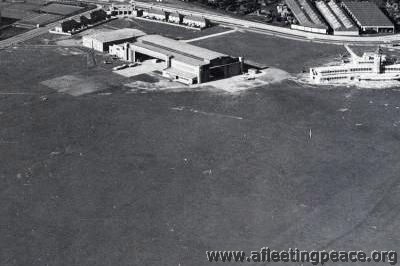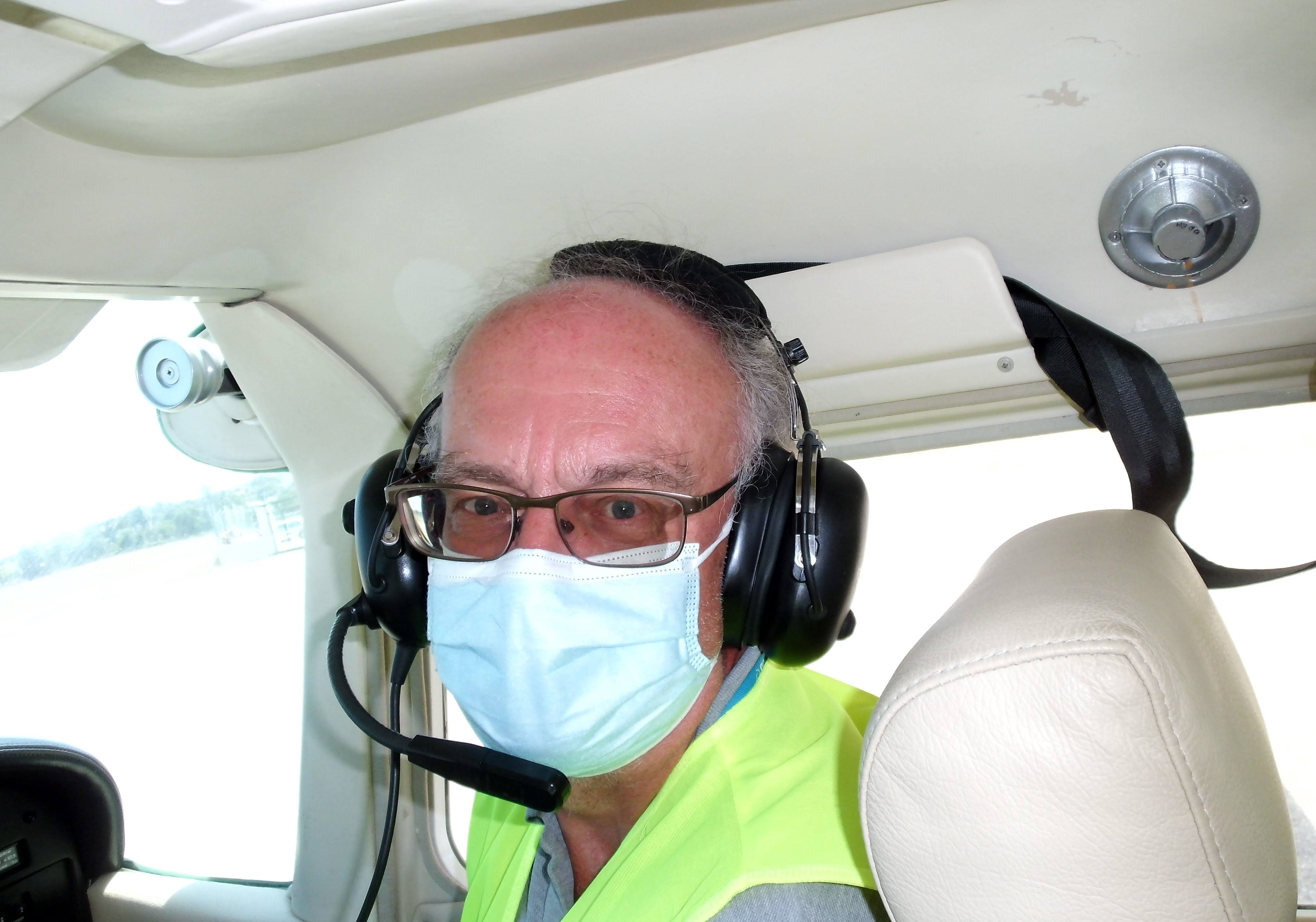|
MacRobertson hero (Part I).
b. 22 August 1899 in Brighton
RNAS in WWI, then moved to Kenya as a 'soldier settler'. Persuaded Mrs Florence Kerr Wilson to set up Wilson Airways in 1929, and became her managing director and chief pilot until 1932 when he returned to England as personal pilot to Lord Marmaduke Furness. He always liked horses.
Married Florence Desmond (a famous actress and comedienne) in 1935, before Charles Hughesdon (see below) did.
See here:  for a movie of CWA Scott and Tom Campbell Black explaining how they got from Mildenhall to Melbourne (although Tom, too busy having a fag, don't say much. He only says 'Kircut', actually) for a movie of CWA Scott and Tom Campbell Black explaining how they got from Mildenhall to Melbourne (although Tom, too busy having a fag, don't say much. He only says 'Kircut', actually)
Tom's obituary, in The Aeroplane - September 23, 1936 by Charles G Grey, the Editor
Tom Campbell Black was killed at the Liverpool Municipal Aerodrome at Speke on September 19 in an accident of a kind which has happened over and over again without harm to anybody. That Tom Black of all people should have been killed in such an accident is a freak of Fate.
At present the north side of Speke airport is occupied by 611 West Lancashire (Bomber) Squadron, Auxiliary Air Force. On Saturday Tom Black, who had flown up from Gravesend a day or two before in the Mew Gull in which he was to compete in the Johannesburg Race, was demonstrating the machine to the Liverpool people who had backed him in the race. He had made several flights, and an experienced pilot who saw them said that Tom Black's last landing was the best he had ever seen in a Mew Gull or anything else, and that his landings were better and better after each flight.
To make inspection by the public easier the machine was in a little roped-in enclosure close to the RAF's Bessonneaux temporary sheds. At four o'clock in the afternoon Tom Black started out from this little enclosure intending to fly the machine back to London. His line when taxying out to the proper place from which to take off at the Western side of the aerodrome down by the river against an East wind took him parallel with the boundary of the landing area - necessarily in the direction from which any machine landing into the wind in the ordinary way would arrive.
At that moment Flying Officer P S Salter, RAF, who had taken one of 611's Harts up for a test, was coming in to land, which he did in a quite orthodox and proper manner - up-wind towards the squadron's sheds.
Tom Black started taxying out with a man on each wing-tip. A short way from the enclosure he signalled to the men to let go and speeded up to about 15 mph, then he slowed to about 10mph and was to be seen looking at something in the cockpit. That probably accounted for his not seeing the Hart coming in.
The pilot of the Hart obviously could not see him, and so long as pilots are stuck behind massive motors they never will have a chance of avoiding collisions on the ground.
Those on the ground saw what was happening, but naturally could do nothing to stop it. The Hart came slowly on, taxying towards the sheds, and the left wing of the Mew Gull hit the left leg of the undercarriage of the Hart, which collapsed. Apparently the first revolution of the airscrew of the Hart after the impact hit the top of the Mew Gull's left wing and the next tore straight across the cockpit. The screw then hit Tom Black, who evidently threw up his hands to protect his head when he saw the Hart looming over him, and the screw hit him on the side so that he died from internal injuries.
The narrowness of margin between this fatal accident and what might have been merely an annoying collision is shown by the fact that the windscreen, or rather the forward fixed part of the transparent cover of the cockpit, is untouched, as also is the back-board of the cockpit against which the seat rests. A foot either way would have saved him.
If the machines had met head-on the Hart would probably have removed the motor from the Gull, and though there would have been a fire the impact between the machines would have been so slight that the odds would have been in favour of Tom Black getting out. If the machines had met at a slightly different angle the airscrew of the Hart would probably have chewed up the wing of the Gull and would never have touched the cockpit at all. And naturally if either had been going at different speeds, faster or slower, the collision would never have happened, because the angle of their tracks, which was estimated by an experienced on-looker at about 170 degrees, would just have allowed them to clear one another.
Tom Campbell Black was born in 1899. He went to the Royal Naval School at Greenwich, where he was when war broke out in 1914. Thence he joined the RNAS at Cranwell in 1917. Naturally he was best known even among aviating people, as co-pilot with CWA Scott, of the de Havilland Comet which won the MacRobertson Trophy and its £10,000 first prize in the race from Mildenhall to Melbourne. Later he added somewhat to his reputation by flying from London to Cairo in something under twelve hours, - but these were minor affairs when compared to his real service to British Aviation as the great pioneer of Air Transport in East Central Africa.
With the financial help of that far-sighted lady, Mrs Wilson of Nairobi, he started Wilson Airlines, which today is linked up with Imperial Airways, and was the foundation of air transport in our East African colonies. Tom Black himself made thirteen journies by air between Kenya Colony and England, which did much to convince East Africa. Also by way of proving his arguments he flew round the capitals of Kenya, Tanganyika, Uganda, and Zanzibar in a day.
For all that work rather than for the merely ephemeral notoriety of hitting up a few records Tom Black deserves to be remembered as one of the builders of British Aviation.
As an inidvidual Tom Black was one of the most lovable persons I have met. His Service work and his African flying proved that he was all that a man should be, and he had a far-seeing commercial sense, but with it all he had a sort of juvenile charm and simplicity which endeared him to all who knew him at all well. Everything appealed to him as being intensely amusing, and yet he had an earnest and serious side to his character.
His sense of humour was immense. If only one could get some of his Central African adventures down on paper just as he told them they would be a great success. His story of the Serengetti lion which killed the American tourist who tried to take a kinema picture of it after it had been wounded, and what happened after that, could have been made by Rudyard Kipling into one of his best stories, practically without alteration.
Another of his endearing qualities was his loyalty to his friends. One found it in his admiration for CWA Scott, and his stories of their partnership in their race to Australia. I might make Charles Scott uncomfortable if I wrote all that Tom Black told me about him, but I do think that it is due to both of them to say that when after the Australian race certain handsome financial offers were made to Charles Scott, as the senior pilot, he insisted that Tom Black should share the proceeds with him - and that in an equally proper spirit Tom refused to share.
In March 1935 Tom Black married Miss Florence Desmond. Some day the theatre trade will discover that she is one of the World's greatest tragic actresses, as well as one of our greatest comediennes. In fact the last time I saw Tom he was greatly pleased because at last somebody in the theatre trade had offered his wife a real acting part in a play, instead of just regarding her as a genius in funny films and in cabaret. They were a happy couple, and so completely opposite in temperament that their married life was bound to be a success.
Last year Mr and Mrs Tom Black formed Campbell Black (Aviation) Ltd. to take on any kind of job in aviation. They were the sole directors. The company began its activity by owning a few aeroplanes and letting them out to air circuses and Tom Black used to get quite a lot of fun out of running about the country supervising their activities while preparing bigger schemes. The last time I saw him was on one of those trips to the opening of the Municipal Aerodrome at York. We published a photograph of him at the time. There he was his joyous, boyish self, and that is how I like to remember him.
--------------------
I've read this a few times now, and I still can't quite understand what happened at Speke.
The airport looked like this in 1936:

We are looking north-west; the River Mersey would be bottom left, off the edge of the photo.
If there was an East Wind, aircraft would be taking off and landing into it, so Tom would go to the western end of the landing area.
The Hart would also be landing at the western end, heading east. He would probably land very close to the spot where Tom would be parked, waiting for his turn to take off. The Hart was landing 'up-wind towards the sheds', and then taxied 'towards the sheds'.
So...
what was the Hart doing taxying back westwards? Apparently the two aircraft hit almost head-on - the left wing of the Gull struck the left undercarriage of the Hart. Surely the Gull was static, as Tom was looking for something in the cockpit and obviously not expecting a Hart bomber to suddenly appear on top of him?
...
One explanation is that Tom was parked facing south-south-east, the Hart landed south-west of him and then turned north-west, though I wonder why in that case the Hart pilot didn’t see the Gull.
Unless (and this seems unthinkable) Tom was taxying across the middle of the landing area, not paying proper attention; the Hart landed, came straight on and hit him.
Poor Mr Salter; he must have gone through the rest of his life known as the man who killed TCB.
|
